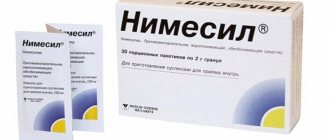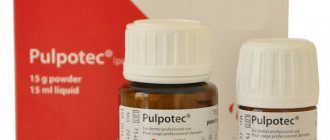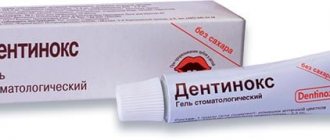pharmachologic effect
Anti-inflammatory, antipyretic, analgesic.
Pharmacokinetics
Nimesulide is well absorbed from the gastrointestinal tract (GIT).
The maximum concentration in blood plasma (Cmax) after oral administration of a single dose of nimesulide, amounting to 100 mg, is achieved on average after 2 - 3 hours and is 3-4 mg / l. Area under the concentration-time curve (AUC) and a decrease in the cumulative excretion of furosemide without changing the renal clearance of furosemide.
special instructions
Side effects can be minimized by using the lowest effective dosage of the drug in a minimally short course.
Nimesil powder medicine should be used with caution in persons with a history of gastrointestinal diseases, since exacerbation of these diseases is possible.
Since the drug is partially evacuated by the kidneys, its dosage for persons with impaired renal function should be reduced depending on the volume of urine excreted.
When the first symptoms of liver damage appear (itching, yellowing of the skin, nausea, abdominal pain, vomiting, dark urine, increased liver transaminases), you must stop taking the medication and consult a doctor.
If any signs of visual impairment appear during drug therapy, the patient should be examined by an ophthalmologist.
Nimesil can provoke fluid retention in the body, so people with high blood pressure and heart disease should use the drug with extreme caution.
If symptoms of an acute respiratory infection of a viral nature occur during drug therapy, Nimesil should be stopped.
Nimesil should not be used simultaneously with other anti-inflammatory non-steroidal drugs.
Nimesulide can change the characteristics of platelets , so care must be taken when using the drug in patients with hemorrhagic diathesis . It is worth remembering that the medicine does not replace the preventive effect of acetylsalicylic acid for diseases of the circulatory system.
Nimesil dosage
Inside. The contents of the sachet are dissolved in approximately 100 ml of water at room temperature (a white or light yellow suspension is formed).
The prepared solution cannot be stored.
The drug Nimesil® is used only for the treatment of patients over 12 years of age.
Adults and children over 12 years old: 1 sachet twice a day, after meals.
Elderly patients: when treating elderly patients, the need to adjust the daily dose is determined by the doctor based on the possibility of interaction with other drugs.
Patients with renal insufficiency: in patients with mild to moderate renal insufficiency (creatinine clearance 30-60 ml/min) no dose adjustment is required, while in patients with severe renal insufficiency (creatinine clearance <30 ml/min) Nimesil ® is contraindicated.
Patients with liver failure:
The use of Nimesil® in patients with liver failure is contraindicated.
To reduce the likelihood of side effects, it is recommended to take the minimum effective dose for the shortest possible time.
The maximum daily dose for adults and children over 12 years of age is 200 mg.
The maximum duration of treatment is 15 days.
Release form and composition
"Nimesil" is produced in the form of a powder for the preparation of a suspension, which is intended for oral administration. The powder is light green in color, coarse-grained, with an orange smell. The main active substance of the drug is nimesulide. Its content per sachet of powder is 100 mg. The auxiliary components of the powder are sucrose, ketomacrogol, maltodextrin, anhydrous citric acid and orange flavor.
The drug is packaged in foil bags of 2 g. One package can contain 9, 15 or 30 sachets.
How to take Nimesil - before or after meals? More on this below.
Overdose
Symptoms: apathy, drowsiness, nausea, vomiting, pain in the epigastric region. These symptoms are usually reversible with symptomatic and supportive therapy. Possible increased blood pressure, gastrointestinal bleeding, acute renal failure, respiratory depression, coma, anaphylactoid reactions.
Treatment: Symptomatic and supportive therapy. There is no specific antidote. If an overdose has occurred within the last 4 hours, it is necessary to induce vomiting and/or take activated carbon (60 to 100 g for an adult) and/or an osmotic laxative. Forced diuresis, hemodialysis, hemoperfusion, and urine alkalization are ineffective due to the high degree of binding of nimesulide to plasma proteins (up to 97.5%). It is necessary to monitor the state of kidney and liver function.
Reviews about Nimesil
For toothache and other types of pain (associated with injuries, algodismenorrhea ), Nimesil powder is widely used. Reviews of its use among patients are positive and there is little evidence of the development of undesirable effects.
Reviews from doctors about Nimesil also well characterize the drug as a remedy that effectively relieves pain of a traumatic nature and pain localized in the musculoskeletal system. However, it is worth remembering that in a number of countries nimesulide are completely prohibited due to increased hepatotoxicity.
Is Nimesil an antibiotic or not?
A common question among patients. Nimesil is not an antibiotic and does not have an antibacterial effect. Its main effects: antipyretic, analgesic, anti-inflammatory.
Precautionary measures
Carefully
Arterial hypertension, diabetes mellitus, compensated heart failure, coronary heart disease, cerebrovascular diseases, dyslipidemia/hyperlipidemia, peripheral arterial disease, hemorrhagic diathesis, smoking, creatinine clearance 30-60 ml/min.
History of ulcerative lesions of the gastrointestinal tract; history of infection caused by Helicobacter pylori; elderly age; long-term previous use of NSAIDs; severe somatic diseases.
Concomitant use with the following drugs: anticoagulants (for example, warfarin), antiplatelet agents (for example, acetylsalicylic acid, clopidogrel), oral glucocorticosteroids (for example, prednisolone), selective serotonin reuptake inhibitors (for example, citalopram, fluoxetine, paroxetine, sertraline).
Properties
Nimesulide is a selective antagonist of cyclooxygenase-2, which has an inhibitory effect on its activity. In response to the formation and development of pathological processes in the form of inflammation, cyclooxygenase-2 provokes a reaction to convert arachidonic acid into prostaglandins, which are the main causative agents of the inflammatory reaction produced by the immune system.
A decrease in the amount of prostaglandins provokes a decrease in the severity of inflammation, and also relieves pain and swelling of tissues, eliminating blood stagnation in the microvasculature.
The active component, when taken as a suspension based on Nimesil, is quickly and effectively absorbed into the bloodstream. Nimesulide distributes evenly throughout the tissues, providing a pronounced therapeutic effect. The active substance is metabolized in the liver through the production of inactive substances, which are subsequently excreted in the urine. The half-life of the drug from the body occurs approximately 6 hours after taking Nimesil.
How long does it take for Nimesil to start working is interesting to many.
Indications
A suspension based on Nimesil powder is taken to reduce the intensity of the inflammatory process, as well as to eliminate pain in certain diseases, including:
- Pain syndrome in the back, namely the lumbar region, against the background of an inflammatory process.
- Pathologies of bone and muscle structures, including various injuries, tendonitis, sprains, subluxations and dislocations of joints, etc.
- Toothache.
- Head pain of various origins, including migraine in varying degrees of intensity of its manifestation.
- Pain during menstrual bleeding.
At what age can Nimesil be taken?
"Nimesil" is used from the age of 12 exclusively as symptomatic treatment of pain and inflammation. However, the cause of the symptoms is not eliminated.
Note!
The description of the drug Nimesil on this page is a simplified author’s version of the apteka911 website, created on the basis of the instructions for use.
Before purchasing or using the drug, you should consult your doctor and read the manufacturer's original instructions (attached to each package of the drug). Information about the drug is provided for informational purposes only and should not be used as a guide to self-medication. Only a doctor can decide to prescribe the drug, as well as determine the dose and methods of its use.
Adverse reactions
When taking a suspension made from Nimesil powder, the following undesirable reactions may appear on the part of some organs and systems of the body:
- Digestive system: nausea with periodic vomiting, diarrhea, sometimes bloating, pain in the abdominal area, constipation, bleeding, accompanied by darkening and tarry texture of the stool.
- Heart and vascular system: increased pressure in the arteries, tachycardia, accompanied by rapid heart rate, hot flashes.
- Biliary system and liver: inflammation of the liver, hepatitis with a rapid course, accompanied by icteric syndrome, increased activity of liver transminases, showing damage to organ cells, the so-called hepatocytes.
- Nervous system: headache, nervousness, dizziness, nightmares, feelings of fear and anxiety.
- Respiratory system: shortness of breath, in rare cases exacerbation of bronchial asthma.
- Urinary system: the appearance of blood in the urine or hematuria, painful urination or dysuria.
- Sense organs: deterioration of visual function.
- Blood and bone marrow: anemia, eosinophilia, thrombocytopenia and other changes in blood parameters.
- Allergies: rash and itching of the skin, increased sweating, rarely urticaria, anaphylactic shock, Quincke's edema, etc. If the latter symptoms appear, you should take immediate medical care, give antihistamines and call an ambulance.
Side effects and contraindications of Nimesil are described in detail in the instructions.
The appearance of the described symptoms while taking the suspension indicates intolerance to the components of the drug and the need for urgent discontinuation of this drug.
Analogs
Pharmacies are ready to offer quite a lot of drugs that are analogues of Nimesil. If you believe the reviews, generics are identical to the original in properties and composition.
“Nise”, “Nemulex”, “Nimesulide” contain the same active ingredient as “Nimesil”, so in principle they are not able to act on the body otherwise. It should be noted that the concentration of the active substance in the listed drugs is identical.
No less effective drugs analogues of Nimesil are:
- "Aponil."
- "Kostral".
- "Mesulide".
- "Nimulid".
- "Nimesan".
- "Niminka."
- "Aulin."
- "Nimegesik", etc.
Many patients suffering from headaches or toothaches often face a choice between Nimesil and Nise. The latter is an effective and cheaper drug, while Nise is produced both in powder and tablet form. It can be given even to children in small dosages.
"Nemulex" and "Nimesil" are absolutely identical drugs. The only thing that differs is their taste, as they contain different excipients. Nemulex is cheaper, so many people choose it.
Which drug is better to choose?
So, which is better Nimesulide or Nimesil? After all, this is practically the same thing, or not? The choice of drug is influenced by the patient's budget and personal preferences.
- For people who do not want to pay for the brand and name of the drug, it is better to choose “Nimesulide”.
- It is also suitable for people who do not know how to independently regulate the dose of medication.
The drugs are completely identical, so you can safely buy an affordable analogue that is not inferior in effectiveness.
- The advantage of Nimesulide is the availability of different forms of release.
This factor plays an important role. Each patient will be able to choose a more convenient option.
- Some patients do not focus on price. They are ready to pay for a drug from a global manufacturer that is responsible for the quality of its product. For such people, Nimesil is more suitable. The medicine has a small list of contraindications and adverse reactions. Moreover, it is significantly more expensive than a similar drug.
Regardless of personal preferences, you should definitely consult a doctor before purchasing a medicine. Both drugs can cause side effects that can turn into serious problems later on.









